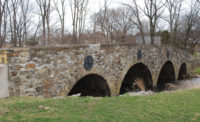The Northampton County, Pa., General Purpose Authority and Kriger Construction Inc. recently entered into a public-private partnership that is believed to be one of the first P3 transportation infrastructure projects nationwide to be spearheaded by county officials.
The $37.5-million replacement and rehabilitation of 33 bridges is a rare example of a county serving as the “lead agent” for a P3 project, said John Parkinson, executive director of the Association for the Improvement of American Infrastructure. “One can’t help but applaud them for being creative,” Parkinson says.
The low-traffic-volume bridges carrying local roads over waterways average 40 ft in length and 24 ft in width. Twenty-eight concrete, stone and steel bridges averaging 70 years in age will be replaced. Another five stone-arch bridges, including some that are more than 100 years old, will be rehabilitated. No federal or state funds are on the table, but the bridges will follow state design guidelines and have a minimum life cycle of 70-plus years.
Stan Rugis, Northampton’s director of public works, said the project will save up to 30% per bridge, compared to conventional municipal bridge contracting. Rugis said the agreement saves taxpayer money by bundling bridgework that, otherwise, might have cost up to $1.5 million per structure. Rugis said the county is using the alternative procurement tool because they are “sick and tired” of paying a premium on the municipal bond market to fund projects. “This contract encompasses the entire project, soup to nuts, along with a [10-year] maintenance period,” Rugis says. “We didn’t give bidders a dime to do paperwork.”
Rugis said Kriger is shouldering the majority of the risk by financing the project itself. James Marzolino, vice president for the Dickson City, Pa., firm, said Kriger likes the project’s steady work and financing flexibility. He noted that, unlike a fixed-bidding process that sets a deal’s terms when a contractor is selected, Kriger negotiated the terms, including the county’s payment structure, after being selected.
Marzolino said the contract allows Kriger the flexibility to fund the work with a combination of self-financing, payments from the county and drawdowns—similar to a line of credit on a house—from local community banks. “The [project] size allowed us to be a little more flexible with the finance options and give the best value to the county,” he says.
Design work is expected to commence this spring. Construction is slated to begin next year and be completed by 2020.
Northampton County Executive John Brown said the county has nearly 70 more bridges that require repair and replacement. Pending state legislation, he would like to use a P3 for a new corrections facility.
Parkinson said the county is “setting the bar higher in terms of innovation.”
Rugis already has fielded calls from other municipalities interested in using P3s. Further, he has met with state and federal officials, including U.S. Sen. Bob Casey (D-Pa.), interested in the project’s details.




